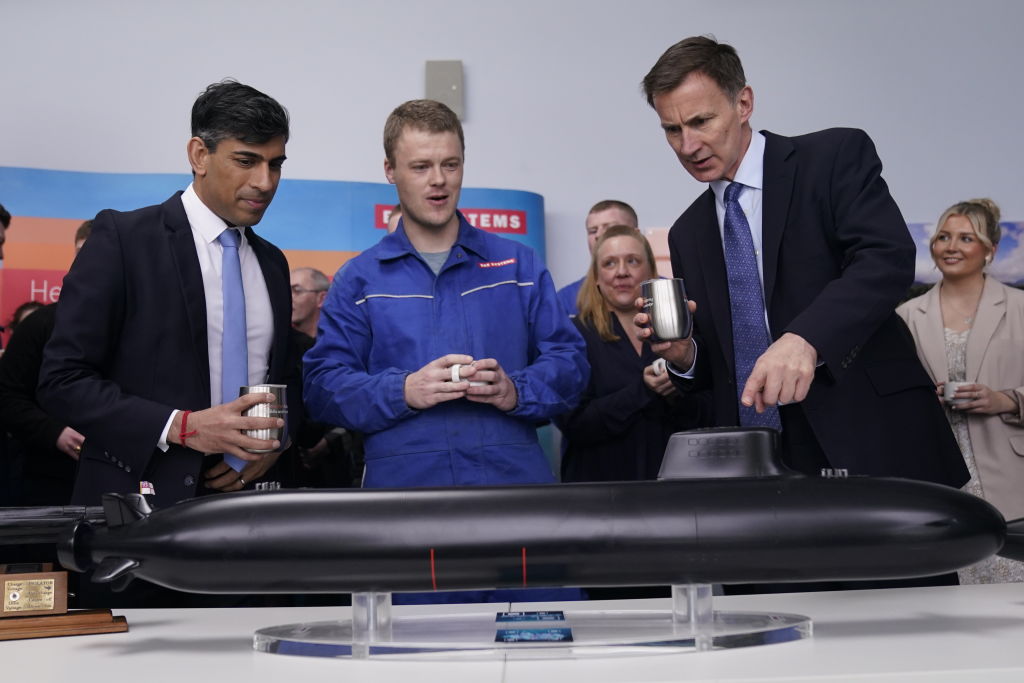(sublinhados meus)
Can Britain afford Trident?
We’re spending more on the deterrent while the armed forces crumble

The prime minister is in Cumbria today, visiting Barrow-in-Furness to announce a ‘national endeavour’ to support the defence and civil nuclear industry. This includes a partnership with companies including BAE Systems, Rolls-Royce, EDF and Babcock to invest more than £760 million in skills, jobs and education over the next six years. The Barrow Transformation Fund will receive £20 million from the government immediately, then £20 million a year for the coming decade.
Barrow is important because it is where the Royal Navy’s new Dreadnought-class ballistic missile nuclear submarines are being built. BAE Systems Submarines also built the Astute-class nuclear-powered attack submarines, of which four are in service with three more to come. Coinciding with Rishi Sunak’s visit to Cumbria, the Ministry of Defence is publishing a Defence Nuclear Enterprise command paper which will ‘set out how the UK will deliver the capabilities necessary to maintain our independent nuclear deterrent’.
This is the sort of announcement that politicians love to make. Anything under the umbrella of national security creates a frisson of excitement and power, as well as an opportunity to put on the serious mask of a statesman rather than the eager, pleading face of an everyday politician. It is why prime ministers come to love international summits, where they are insulated from criticism and sharp words.
But glitzy national security announcements cannot hide the fact that funding for the armed forces is in a perilous state – and the nuclear deterrent comes with a hefty price tag. The current fleet of four Vanguard-class submarines cost the equivalent of more than £20 billion in today’s money, and their replacements may end up costing twice that. The annual operational cost of the deterrent alone is roughly £3 billion, around 6 per cent of the defence budget.
This comes at a time when the Ministry of Defence’s budget is rightly and damningly coming under unremitting scrutiny. Earlier this month, a report by the House of Commons Public Accounts Committee found that the Defence Equipment Plan 2023-2033 shows a deficit of £16.9 billion – that is, the gap between what the armed forces are expected to do, and the funding they have to do it. It is the largest deficit ever seen in a defence plan, and in fact underplays the problem, as it omits the costs of some of the capabilities the MoD requires. The committee estimates that the gap for the army alone is around £12 billion.
Ministers attempt to give the impression that they understand the importance of defence and are committed to strengthening the armed forces. There is an ambition to increase funding to 2.5 per cent of GDP but this will only be ‘when conditions allow’. We will have to hope that our adversaries are just as patient. Meanwhile, the defence secretary, Grant Shapps, is reported to be ‘calling for’ increasing the defence budget to 3 per cent of GDP – as if he were a bystander rather than the minister responsible for defence.
In the real world, the Budget unveiled by the Chancellor, Jeremy Hunt, earlier this month contained no major defence spending announcements. The supporting data instead suggests there will be a decline in resources for the armed forces of £2.5 billion over this financial year. The MoD counters that this does not take into account commitments announced last autumn, and does not include assistance to Ukraine.
The problem of funding is exacerbated by the fact that the nuclear deterrent is virtually immune from marginal cost savings. Nuclear submarines cost what they cost, they are long-term commitments and the Royal Navy absolutely must have four boats to maintain continuous at-sea deterrence. The United Kingdom has had a submarine on patrol, ready to launch nuclear missiles at any target in the world, every minute of every hour of every day since April 1969. That has an irreducible price tag.
Meanwhile the armed forces are threadbare. Last month, the House of Commons Defence Committee put it bluntly in a report entitled (ominously) ‘Ready for War?’ when it said of the services, ‘all have capability shortfalls and stockpile shortages, and are losing personnel faster than they can recruit them. They are also consistently overstretched.’
This is not a debate about the value of the nuclear deterrent. But the government trumpets spending on a weapon of absolute last resort, while the army is unable to generate the war-fighting division on which its operational plans are based and it is smaller than at any time since the 1790s. The defence secretary sighing wistfully about huge increases in funding cannot hide this sleight of hand. Eventually the government will needs to decide whether it wants to increase resources for the armed forces or reduce its capabilities. Either way, something has to give.
Sem comentários:
Enviar um comentário